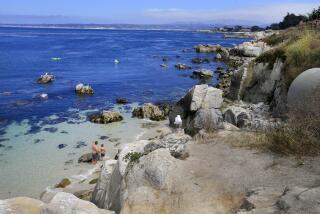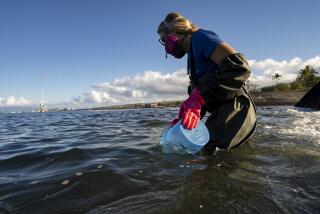Undersea Explorations Track Demise of Coral Reefs
- Share via
OVER THE OCULINA BANKS — The robot swims along the sandy ocean bottom, with a dozen mismatched eyes of cameras, lasers and lights searching for the fish and coral that have been disappearing from this remote spot off Florida’s Atlantic coast.
Some days, the robot finds mounds of the rare ivory tree coral, crumbled into lifeless brown sticks on the ocean floor, and a few signs of the hundreds of species of fish and marine life that used to make their homes amid the coral’s porcelain branches.
Occasionally, a centuries-old pinnacle of the Oculina coral still stands, and the robot swims gingerly around it, sending video and pictures of the habitat to researchers who are charting the robot’s every movement and observation.
Undersea expeditions like this have allowed researchers to follow the demise of the Oculina coral reefs, which sit along the edge of the Florida continental shelf, 30 miles offshore from Daytona Beach to Fort Pierce. Scientists say at least 90% of the deep-water live coral cover has been reduced to rubble since the 1970s, partly by commercial fishing outfits that drag heavy nets through the coral in search of shrimp and fish.
“These reefs are incredible resources found nowhere else on Earth,” said John Reed, chief scientist on the expedition and a coral expert with Harbor Branch Oceanographic Institute in Fort Pierce. “Probably the only way to save it is with more stringent laws and public awareness that this is not something we can re-create in our lifetime.”
By 2000, the National Marine Fisheries Council had protected about 300 square miles of the Oculina banks, making the reefs the East Coast’s first Marine Protected Area. Similar efforts in Norway, New Zealand and Tasmania are protecting other deep-water coral reefs that grow anywhere from 200 to 3,000 feet below the ocean’s surface, harboring thousands of species that use them as a breeding, nursing and feeding ground.
But the rules banning fish nets and anchors aren’t enough to keep the 10,000-year-old reefs intact, largely because the Oculina reefs are remote and patrols are costly.
“A small percent of commercial fishermen that are breaking the rules can do a lot of damage in a very short amount of time,” Reed said. He added that the last shrimp boat caught damaging the reef in 2001 was fined $15,000, likely a fraction of the worth of that week’s catch.
Researchers hope that their work will provide more protections by convincing the National Oceanic and Atmospheric Administration to designate the Oculina reefs as a National Marine Sanctuary.
The snowy white branches of the ivory tree coral, which make up the Oculina banks, grow only about half an inch each year. Pinnacles as fragile as fine china have grown up to 100 feet tall over centuries. When they’re crushed, thousands of crabs, shrimp, snails and clams as well as dozens of species of fish are left homeless.
“You can think of them as giant condominiums, housing projects for small animals,” said Les Watling, an oceanography professor at the University of Maine’s Darling Marine Center in Walpole, who studies the creatures living deep in the ocean.
Watling said those who destroy the reefs won’t be able to return to the once-rich fishing spot because it will disappear after the first catch.
“It’s obviously foolish and shortsighted to smash these reefs,” he said. “It’s on par with cutting down the ancient redwood forests in California.”
But unlike the redwoods, which are enjoyed by millions of visitors each year, the Oculina banks can only be visited by robots like the Phantom SII and other submersible vehicles.
For that reason, researchers using the robot aboard the Freedom Star, a NASA ship normally used to retrieve solid rocket boosters, are working to put together a complete picture or database describing the reefs. The project, funded by an $87,000 NOAA grant, will help determine whether federal protection should be expanded for the Oculina banks past 2004, when the current protections expire.
“It is really a very good tool for getting right close to the bottom, to be able to establish what life is like,” said Andy Shepard, the expedition’s chief operator.
More to Read
Sign up for Essential California
The most important California stories and recommendations in your inbox every morning.
You may occasionally receive promotional content from the Los Angeles Times.










